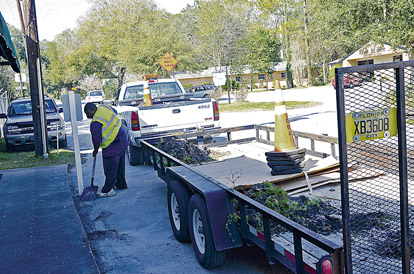ALACHUA –When Alachua City Commissioner Gary Hardacre’s children graduated, they had to leave town to find a job, he said at an Alachua City Commission meeting. The next generation may be more fortunate, as another 164 jobs are coming to the city of Alachua.
Coqui Radio Pharmaceuticals Corp. selected Alachua as the site for a new facility for designing, constructing and supplying medical isotopes.
Over 10,000 hospitals worldwide use radioisotopes in medicine, mainly for diagnosis procedures, according to the World Nuclear Association. The isotopes are generally injected, inhaled or taken orally, giving off energy that can be detected and tracked by special equipment so doctors can learn more about what parts of the body are failing or diseased.
The 164 jobs will be created over a three-year period, said Assistant City Manager Adam Boukari at the Monday, Feb. 24 commission meeting.
They will range from unskilled jobs to careers requiring doctoral degrees, said Susan Davenport, vice president of economic development for the Gainesville Area Chamber of Commerce. About 87 of the jobs are unskilled or semi-skilled, she said.
Not only will residents of Alachua have more jobs available, but people from all around the area will too, Davenport said.
“It will be a great opportunity for people in the region,” she said.
It’s a time for Alachua to be on the map and shine, said Alachua Mayor Gib Coerper.
The new 100,000 square-foot facility, with a capital investment of $227 million over the next for years, is the only of its kind in the country and one of only three or four in the entire world, Davenport said. The average annual compensation for workers will be $70,000.
Because there is a shortage of one of the particular isotopes the company will create, Alachua will have a chance to have a major impact on global health, she said.
At the Feb. 24 meeting, the commission approved a motion to offer Coqui a Qualified Target Industry Tax Refund.
Coqui qualified for a $7,000 tax credit for each job that will be created, amounting to $1,148,000.
The program requires a 20 percent match from local government, meaning local government will provide $229,600. The City of Alachua will provide $114,800, with Alachua County providing the rest.
The program was set up by the state to make Florida an attractive environment to business.
In order to be considered, companies have to apply to the Florida Department of Economic Opportunity. There are six criteria. The company has to be in a target industry, demonstrate it will make a material difference in expanding the local community, create at least 10 new full-time jobs or expand an existing operation by 10 percent, pay an average annual wage at least 115 percent of the state or local wages, demonstrate the jobs make a significant contribution to the area and get a resolution passed by local government to commit to providing 20 percent of the refund.
Last year, Alachua-based Encell Technology, which designs high-efficiency batteries, received just a little over $1 million in tax credits from the program.
# # #
Email cmckinney@
alachuatoday.com
Add a comment


